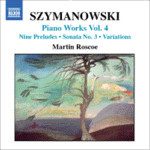
Szymanowski: Piano Works Vol 4 (9 Preludes, Op. 1 Piano Sonata No. 3, Op. 36 etc )
 $25.00
Out of Stock
$25.00
Out of Stock6+ weeks add to cart
KAROL SZYMANOWSKI
Szymanowski: Piano Works Vol 4 (9 Preludes, Op. 1 Piano Sonata No. 3, Op. 36 etc )
Martin Roscoe (piano)
[ Naxos / CD ]
Release Date: Thursday 8 December 2005
This item is currently out of stock. It may take 6 or more weeks to obtain from when you place your order as this is a specialist product.
"Martin Roscoe - a pianist of considerable ability - he has obviously dedicated a great deal of time to this composer, and the hard work pays off in spades. His readings are authoritative and convincing"
(MusicWeb Feb 2006)
"All four of Roscoe's discs are recommendable and hopefully Naxos will bring his series together. Meanwhile, volume 4 would be the obvious sampler with music spanning Szymanowski's entire career and illustrating his development."
(MusicWeb Jan 2006)
"Martin Roscoe - a pianist of considerable ability - he has obviously dedicated a great deal of time to this composer, and the hard work pays off in spades. His readings are authoritative and convincing"
(MusicWeb Feb 2006)
"A convincing presentation of fascinating music, and the resounding completion of a very desirable series"
(MusicWeb April 2006)
Karol Szymanowski was born in 1882, the same year as both Stravinsky and Kodály, to an aristocratic Polish family in the Ukraine. He was the third of five children, all of whom pursued careers in the arts, and displayed a keen interest in both music and literature. Owing to a leg injury at the age of four his early education was at home, where, under his father's direction, he began to study the piano from the age of seven. Later he was sent to his uncle Gustav Neuhaus's music school to study both piano and theory. It was under his tutelage that Szymanowski was introduced to the works of Bach, Mozart, Beethoven, Brahms and, naturally, Chopin. His first published work was a set of nine Chopinesque Preludes, written between 1896 and 1900, although not published until 1906. In 1901 he moved to Warsaw for further study, taking lessons from Zygmunt Noskowski in counterpoint and composition and from Marek Zawirski in harmony. It was here that he established friendships with a small group of remarkable musicians who were all to become important interpreters of his music, the pianist Artur Rubinstein, the violinist Pawel Kochaƒski, and the conductor Grzegorz Fitelberg. Together with Fitelberg and two other students of Noskowski, Ludomir Ró. zycki and Apolinary Szeluto, Szymanowski established the group known as 'M1oda Polska' (Young Poland), in order to publish and promote new Polish music.
Besides the strong influence of his compatriot, Chopin, other key influences throughout Szymanowski's early creative life included the music of Wagner, Strauss, Reger and Scriabin, as can be heard in works such as the Symphony No. 2 (1909-10) (Naxos 8.553683) and the one-act opera Hagith (1912-13). With the outbreak of World War I, Szymanowski returned home from travel abroad that had taken him to Italy, Sicily, Algiers, Constantine, Biskra and Tunis, concentrating his attention on composition. Having by now discovered the music of Debussy, Ravel and Stravinsky, thereby freeing himself from the clutches of late German romanticism, he reached his creative maturity in a series of works written in 1915 that included Métopes for piano (Naxos 8.553016), Myths for violin and piano, and Songs of the Fairy Princess (8.553688) for coloratura soprano and piano. Until the shattering experience of the Russian Revolution, in which his family estate was destroyed, this was Szymanowski's most fertile creative period. Other key works written around this time include the Third Symphony (1914-16) (8.553684), the First Violin Concerto (1916) (8.553685), the twelve Etudes (1916) and the First String Quartet (1917).
It was following a trip to Paris in 1921, when Szymanowski had the overwhelming experience of hearing Stravinsky play Les Noces at the piano (the two had met for the first time in London in 1914) that Szymanowski felt inspired to write a series of works drawing on the folk-music of the Tatra mountains in southern Poland. This third creative phase witnessed the creation of the one-act ballet Harnasie (1923-31) and the String Quartet No. 2 (1927) (Naxos 8.554315) among other works. Szymanowski died at a Lausanne sanatorium in 1937 at the age of 54, having succumbed to a tubercular infection.
Tracks:
2 Mazurkas, Op. 62
20 Mazurkas, Op. 50 (excerpts)
9 Preludes, Op. 1
Piano Sonata No. 3, Op. 36
Valse Romantique
Variations in B flat minor, Op. 3
